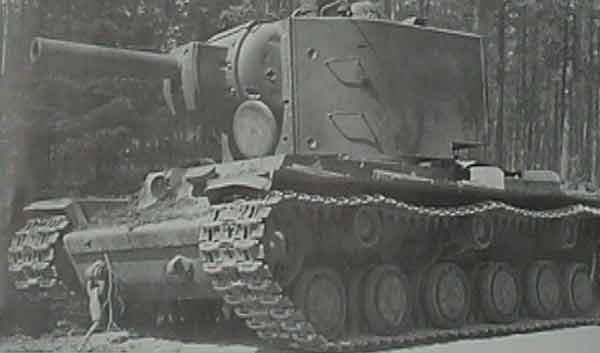|
|
|
|
KV-1 |
|
|
|
The KV-1 design was named after Soviet Marshal Klementy Voroshilov. At the time of it's appearance in 1941, the KV-1 was the most formidable tank in the world. Designed to withstand armour piercing rounds, yet for a heavy tank, it's mobility was not sacrificed. Like the T-34/76, the KV-1 posed serious problems for the German army. While both tanks were superior to the German armour of the day, better trained crews and tactics kept the Wehrmacht rolling eastward. Some good points worth mentioning
Just a couple drawbacks worth mentioning; |
|
|
|
Until the Germans had better tanks rolling out of their factories to deal with the latest Russian
armour, they improvised by deploying the deadly 88mm dual purpose gun with advanced guards. This
could only be a temporary measure due to the fact that the 88 was towed and slow to deploy. It also
lacked sufficient protection for the crews against enemy fire. |
|
SPECIFICATIONS: KV-1 |
DESIGNATION | KV-1 |
|---|---|
TYPE | HEAVY TANK |
LENGTH | 6.68m (21.91ft) |
WIDTH | 3.32m (10.89ft) |
HEIGHT | 2.71m (8.75ft) |
WEIGHT | 43.5 TONS |
CREW | 5 |
ARMAMENT | 76.2mm GUN |
ENGINE | V-2k V-12 600hp |
RANGE | 150km (93.2 miles) |
SPEED | 35km/h (21mph) |
FORDING | UNKNOWN |
TRENCH CROSSING | UNKNOWN |
FRONTAL HULL ARMOUR | 30mm |
|
KV-2 |
 |
|
Unlike the T-34/85 which was an improved follow up of a good design in the T-34/76. The KV-2 was a poor follow up of a good design in the KV-1. Mounting an impressive 152mm gun resulted in the turret being just to big making the vehicle clumsy, to tall, and presenting itself as a clear target. The bearings used in traversing the turret were poorly designed as well and hindered the tanks ability to rotate the turret when the tank wasn't level. In all, the tank couldn't fire on the move. Up against a highly mobile German army, the KV-2 had to many inadequacies and were phased out by the end of 1941. However, after 1941, the KV-1 remained a formidable tank though in the autumn of 1942 the German's Tiger 1 made it's appearance and the KV-1 met more than it's match. The KV-1's evaluation remained in progress as the forthcoming Joseph Stalin series of heavy tanks would incorporate many of its features. |
|
SPECIFICATIONS: KV-2 |
DESIGNATION | KV-2 |
|---|---|
TYPE | HEAVY TANK |
LENGTH | 6.79m (22.3ft) |
WIDTH | 3.32m (10.89ft) |
HEIGHT | 3.65m (12ft) |
WEIGHT | 52 TONS |
CREW | 6 |
ARMAMENT | 152mm GUN |
ENGINE | V-2k V-12 600hp |
RANGE | 140km (87.5 miles) |
SPEED | 25.6km/h (16mph) |
FORDING | UNKNOWN |
TRENCH CROSSING | 2.95m (8.5ft) |
FRONTAL HULL ARMOUR | 30mm |
| HOME | BACK | TOP |